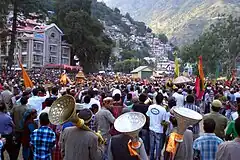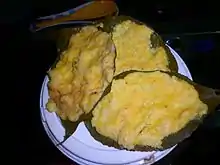The North Indian state of Himachal Pradesh is a state that has remained largely uninfluenced by Western culture. Himachal Pradesh is a multi-religion practising, multicultural and multilingual state. Some of the most commonly spoken languages are Hindi and the various Pahari languages.[1] The Hindu communities residing in Himachal include the Brahmins, Rajputs, Kannets, Rathis and Kolis. There are also tribal population in the state which mainly comprise Gaddis, Kinnarms, Gujjars, Pangawals and Lahaulis.[2]
Himachal is well known for its handicrafts. The carpets, leather works, shawls, paintings, metalware and woodwork are worth appreciating. Pashmina shawl is one of the products which is highly in demand not only in Himachal but all over the country. Himachali caps are also famous artwork of its people.
Local music and dance reflects the cultural identity of the state. Through their dance and music, they praise their gods during local festivals and other special occasions.
There are a number of fairs and festivals celebrated in Himachal Pradesh, including the temple fairs in nearly every region that are of great significance to this state.
The day-to-day food of Himachalis is very similar to the rest of the north India. They too have lentil, broth, rice, vegetables and bread, etc. As compared to other states in north India, non-vegetarian cuisine is more preferred. Some of the specialities of Himachal include Manee, Madeera, Pateer, Chouck, Bhagjery and chutney of til.
The Annual Festival of Kasol known as Himachal Hills Festival which take place from 27 to 30 December every year in Kasol.[3]
People and culture
Around 96% of the population of the state is of Hindus. The major communities include Brahmins, Rajputs, Choudharies, Kannets, Rathis and Kolis. The tribal population comprises the Gaddis, Kinnars, Jadun, Tanolis. Gujjars, Pangawals and Lahaulis. From the alpine pasture regions to the lower regions during the cold winter season are mainly Hindus. The Kinnars are the inhabitants of Kinnaur and they generally practice polyandry and polygamy. The Gujjars are nomadic people who rear buffalo herds and are mainly Muslim. The Lahaulis of Lahaul and Spiti and native of spiti, Kinnaur region mainly comprises Buddhists.[4] A percentage of people are also Tibetans. Muslim, Christian and Sikhs.
Though Hindi is the state language, many people speak the various Western Pahari languages. A majority of the population is engaged in agricultural practices, however the more educated of them are now moving towards tertiary sectors. As per the traditional dressing norms the dress of the Brahmin male includes dhoti, kurta, coat, waistcoat, turban and a hand towel while that of the Rajput male consists of tight fitting churidar pyjamas, a long coat and a starched turban. With the changing time the dress up of the people has now become a mixed one. Though the above-mentioned style is now hardly followed, people have started wearing western style of clothes.
The typical house is constructed of clay bricks and the roofs are of slate. In some areas the slate roof is also replaced by timber.
Arts and crafts
The handicraft that comes out of this state are the carpets, leather works, shawls, metalware, woodwork and paintings. Pashmina shawl is the pretty product which is in high demand not only in Himachal but all over the country. Colourful Himachali caps are also famous art work of the people. A tribe namely Dom is expert in manufacturing bamboo items like boxes, sofas, chairs, baskets and rack. Metalware of the state include utensils, ritualistic vessels, idols, gold and silver jewelleries.
Weaving, carving, painting, and chiselling are considered to be the part of the life of Himachalis. Himachal is well known for designing shawls especially in Kullu. The architecture, objects, shops, museums, galleries and craftsmen charm with the variety perfected through time.
Women take an active part in pottery and men in carpentry. For ages, wood is used in Himachal in the construction of homes, idols etc.
Music and dance
Music and dance of Himachal Pradesh reflects its cultural identity. Through their dance and music, they entreat their gods during local festivals and other special occasions. There are also dances that are specific to certain regions of the state.
Some of the dance forms of Himachal are Losar Shona Chuksam (Kinnaur), Dangi (Chamba), Gee Dance and Burah dance, (Sirmour), Naati, Kharait, Ujagjama and Chadhgebrikar (Kullu) and Shunto (Lahaul & Spiti). The main dance form of Himachal Pradesh is nati. People of the state generally prefer folk music. There is no classical form of music, as for the Himachal Pradesh is concerned. Himachali dance forms are highly varied and quite complicated. These dances are a very vital part of the tribal life. It reflects the culture and the tradition of Himachal Pradesh. Hardly any festivity here is celebrated without dancing. Some of the dance forms like Dulshol, Dharveshi, Drodi, Dev Naritya, Rakshas Nritya, Dangi, Lasa, Nati and Nagas are danced all over the region.
Fairs and festivals

Apart from the fairs and festivals that are celebrated all over India, there are number of other fairs and festivals also that are at the high point of Himachal Pradesh. These festivals are the time for the Himachalis to adorn colourful dress and accessories and get mixed up with the rest of their kins. Some of these fairs and festivals in the upper regions are the Kullu Dussehra, Shivratri Fair (Mandi), Shoolini Mela (Solan), Minjar Fair (Chamba), Mani Mahesh Chhari Yatra (Chamba), Renuka fair (Sirmaur), Lavi Trade Fair (Rampur), Vrajeshwari fair (Kangra), Jwalamukhi Fair (Jwalamukhi), Holi Fair (Sujanpur Tira), and Naina Devi Fair (Bilaspur), Fulaich {Kinnaur valley}. In the lower regions of Himachal are temple Fairs in Una District such as the Peeplo Fair, the Bharoli Bhagaur Fair, the 'Mairi' Guruduwara Fair, the 'Chintpurni' temple Fair, the 'Kamakhya temple' Fair, including the annual Himachal Hill Festival in the village Polian Purohitan during the fourth week of October. The centuries-old Sair festival[5] is celebrated mainly in Shimla, Kangra, Mandi, Kullu and Solan districts every year in mid-September. It is celebrated to mark the end of the crop harvest and also the rakhi thread are removed and offered to the mother sairi.
Food

The day-to-day food of Himachalis is very similar to the rest of north India. They too have lentil, broth, rice, vegetables and bread, Rajmaha, Sidhu. As compared to other states in north India non-vegetarian cuisine is preferred. Traditionally, Himachali cuisine is dominated by red meat and wheat bread. Thick and rich gravy, with aromatic spices, is used in abundance as the base of many dishes. Dham is the traditional food served in marriages or other functions. Siddu, Patrode, Cheele,Tudkiya Bhath and Babru are the authentic snack dishes of the state. Now, steamed momos (dumplings) and noodles are also readily available and popular with travellers who want to graduate to Indian food slowly.[6] Some of the specialities of Himachal include Manee, Mandra or "Madra", "Palda", "Redu" Patrode, Chouck, Bhagjery and chutney of til (sesame seeds).
References
- ↑ "The people and tribes". www.123himachal.com. Retrieved 20 May 2007.
- ↑ "Culture of Himachal Pradesh". Indialine (2007). Archived from the original on 20 August 2011. Retrieved 3 May 2007.
- ↑ "Himachal to celebrate Himachal Hills Festival from December 30–31". Times of India Travel.
- ↑ Ethnicity of Himachal Pradesh Archived 2 April 2007 at the Wayback Machine Retrieved 27 May 2007
- ↑ "Sair Festival". disttmandi.com. 17 September 2015. Retrieved 17 September 2018.
- ↑ "Himachali Cuisine, a Pleasantly Surprising Fusion". www.onetikk.com. Archived from the original on 16 February 2013. Retrieved 31 January 2013.